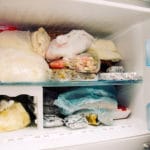If your Kenmore refrigerator is not cooling, you’re likely experiencing one of the most common appliance problems. There are a few things you can do to troubleshoot the problem and get your fridge back up and running.
In this article, we will discuss some of the most common causes of a Kenmore refrigerator not cooling and provide tips on how to fix them.
Solution 1: Condenser Coils are Dirty
The condenser coils are generally found beneath the refrigerator. They remove heat as refrigerant passes through them. The condenser coils will not dissipate heat effectively if they are dirty.
Debris builds up on the coils, making the fridge less effective and necessitating it to work harder to cool down. If the condenser coil is contaminated, it will likely need to be cleaned.
Solution 2: Condenser Fan Motor is Faulty
The condenser fan motor pulls air over the condenser coils and the compressor. If the fan motor isn’t working right, the refrigerator won’t cool right. To see if the fan motor is bad, check to see if there are any obstructions in the fan blade.
You can also try turning the fan blade by hand. If it doesn’t spin freely, the motor is likely bad and will need to be replaced.
Related: How to Reset Whirlpool Refrigerator
Solution 3: Evaporator Fan Motor is Faulty
The evaporator fan motor draws air over the evaporator (cooling) coils and circulates it throughout the refrigerator and freezer compartments. Some refrigerators have more than one evaporator fan motor.
The evaporator is in the freezer compartment on refrigerators with just one evaporator. If the evaporator fan fails to operate, it will not send cold air throughout the refrigerator.
The freezer may keep cool while the refrigerator will not, as a result of this failure. If the evaporator fan motor is defective, try manually turning the fan blade to see if it spins freely. If the fan blade does not spin easily, replace the fan motor. Replace the motor if it’s making unusual noises.
Solution 4: Start Relay is Defective
The start relay connects to the start winding and is used to turn on the compressor. The compressor may occasionally not operate or run slowly if the start relay is faulty. As a result, the refrigerator will not be cold enough.
Check for continuity between the run and start terminal sockets of the start relay using a multimeter to determine whether it is defective.
Solution 5: Temperature Control Thermostat is Defective
When the temperature control thermostat is energized, it connects voltage to the compressor, evaporator fan motor, and condenser fan motor (if applicable). If the temperature control thermostat is faulty, it might prevent the refrigerant system from operating.
You can check the thermostat by rotating it from its lowest position to its highest one and listening for a click. The thermostat clicking suggests that it is not faulty. If the temperature control thermostat does not have continuity at any setting, replace it.
Solution 6: Start Capacitor is not Working
The start capacitor gives the compressor a boost of power when it is initially running. If the start capacitor isn’t functioning, the compressor may not start. As a result, the refrigerator won’t keep cool. Using a multimeter, check if the start capacitor is working properly. If the start capacitor is bad, replace it.
Related: LG Refrigerator Modes
Solution 7: Temperature Control Board is not Working
The thermostat transmits temperature data to the controller, which then regulates the compressor and fan motors. If a temperature control board is faulty, it will cease to provide voltage to the cooling system.
This is not something that happens very frequently. When replacing a control board, first test all of the more commonly defective components before doing so. Replace the temperature control board only if all else fails.
Solution 8: Thermistor is Defective
The thermistor senses the refrigerator temperature and transmits it to the control board. The control board regulates power to the compressor and evaporator fan according to the thermistor readings. If the thermistor is faulty, the compressor and evaporator fan may not turn on as needed.
The refrigerator will not be chilly enough as a result of this scenario. Check the thermistor with a multimeter to see if it is broken. The resistance of the thermistor should alter in tandem with the refrigerator’s temperature. If, after replacing the thermistor, the resistance does not change or there is no continuity, it is time to replace it
Solution 9: Compressor is Broken
The compressor compresses the refrigerant and circulates it through the evaporator and condenser coils. If the compressor fails, the refrigerator will not operate. However, this is uncommon. Check all of the more common faulty components first before replacing the compressor.
If all of the other elements are in good operating order, inspect the compressor. Check for continuity between the electrical pins on the side of the compressor with a multimeter. If there is an open circuit, it’s likely that the compressor is deficient. A certified technician must replace a faulty compressor.
Solution 10: Main Control Board is Defective
It’s possible that the main control board is bad. However, this is not usually the case. Before replacing the main control board, check all of the other frequently malfunctioning components first.
If none of the other components are faulty, consider replacing the main control board.
Conclusion
If your refrigerator isn’t keeping things cool, there are a number of possible causes. In this article, we’ve explored the most common reasons why refrigerators don’t work and how you can address them to get your fridge back in order.
If none of these solutions seem to be working for you or if it’s just been a while since you serviced your fridge, we recommend calling in a professional to take a look.






